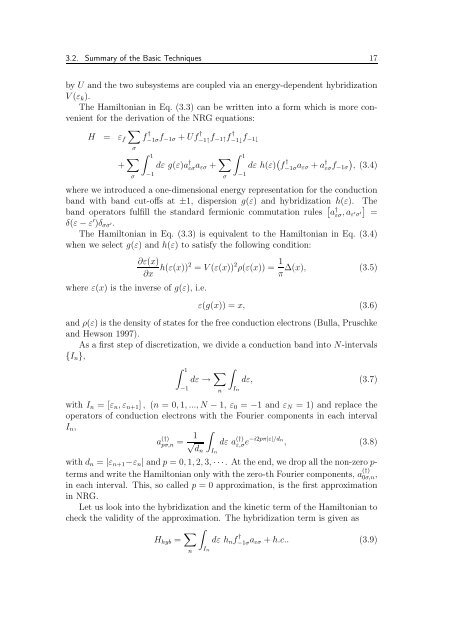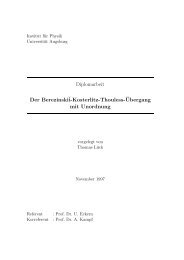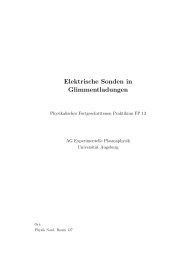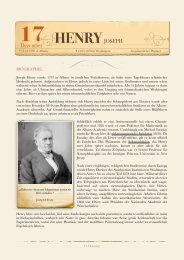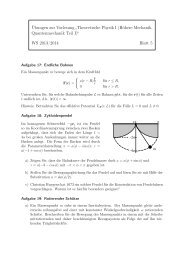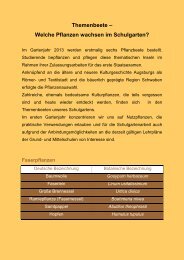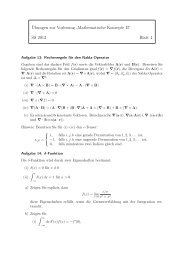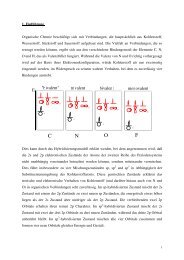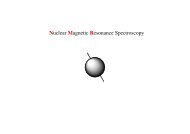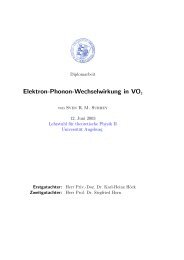Numerical Renormalization Group Calculations for Impurity ...
Numerical Renormalization Group Calculations for Impurity ...
Numerical Renormalization Group Calculations for Impurity ...
Create successful ePaper yourself
Turn your PDF publications into a flip-book with our unique Google optimized e-Paper software.
3.2. Summary of the Basic Techniques 17<br />
by U and the two subsystems are coupled via an energy-dependent hybridization<br />
V (ε k ).<br />
The Hamiltonian in Eq. (3.3) can be written into a <strong>for</strong>m which is more convenient<br />
<strong>for</strong> the derivation of the NRG equations:<br />
∑<br />
H = ε f f −1σf † −1σ + Uf † −1↑ f −1↑f † −1↓ f −1↓<br />
σ<br />
+ ∑ σ<br />
∫ 1<br />
−1<br />
dε g(ε)a † εσ a εσ + ∑ σ<br />
∫ 1<br />
−1<br />
dε h(ε) ( f † −1σ a εσ + a † εσ f −1σ)<br />
, (3.4)<br />
where we introduced a one-dimensional energy representation <strong>for</strong> the conduction<br />
band with band cut-offs at ±1, dispersion g(ε) and hybridization h(ε). The<br />
band operators fulfill the standard fermionic commutation rules [ a † εσ, a ε ′ σ ′ ]<br />
=<br />
δ(ε − ε ′ )δ σσ ′.<br />
The Hamiltonian in Eq. (3.3) is equivalent to the Hamiltonian in Eq. (3.4)<br />
when we select g(ε) and h(ε) to satisfy the following condition:<br />
where ε(x) is the inverse of g(ε), i.e.<br />
∂ε(x)<br />
∂x h(ε(x))2 = V (ε(x)) 2 ρ(ε(x)) = 1 ∆(x), (3.5)<br />
π<br />
ε(g(x)) = x, (3.6)<br />
and ρ(ε) is the density of states <strong>for</strong> the free conduction electrons (Bulla, Pruschke<br />
and Hewson 1997).<br />
As a first step of discretization, we divide a conduction band into N-intervals<br />
{I n },<br />
∫ 1<br />
dε → ∑ ∫<br />
dε, (3.7)<br />
−1 n I n<br />
with I n = [ε n , ε n+1 ] , (n = 0, 1, ..., N − 1, ε 0 = −1 and ε N = 1) and replace the<br />
operators of conduction electrons with the Fourier components in each interval<br />
I n ,<br />
a (†)<br />
pσ,n = √ 1 dε a<br />
dn<br />
∫I (†)<br />
ε,σe −i2pπ|ε|/dn , (3.8)<br />
n<br />
with d n = |ε n+1 −ε n | and p = 0, 1, 2, 3, · · ·. At the end, we drop all the non-zero p-<br />
terms and write the Hamiltonian only with the zero-th Fourier components, a (†)<br />
0σ,n,<br />
in each interval. This, so called p = 0 approximation, is the first approximation<br />
in NRG.<br />
Let us look into the hybridization and the kinetic term of the Hamiltonian to<br />
check the validity of the approximation. The hybridization term is given as<br />
H hyb = ∑ ∫<br />
dε h n f −1σa † εσ + h.c.. (3.9)<br />
n I n


